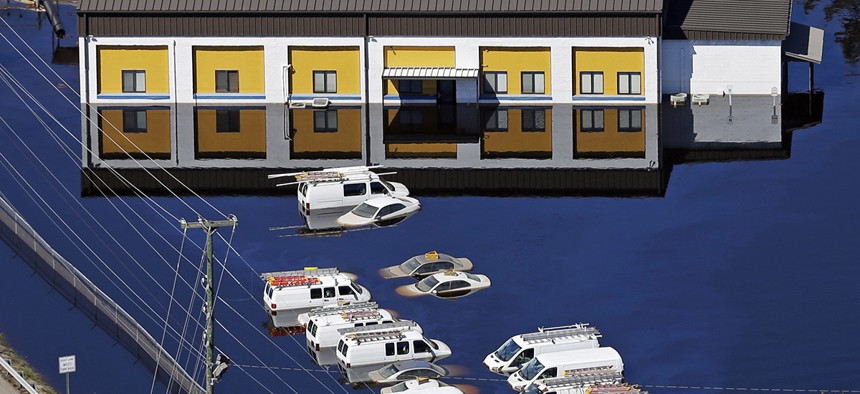Could Self-Driving Cars Speed Hurricane Evacuations?

Vehicles at a business are surrounded by floodwaters from Hurricane Matthew in Lumberton, N.C., Wednesday, Oct. 12, 2016. Chuck Burton/AP
The case for a fully autonomous escape plan
Hurricane Matthew’s record rains were but the first of many obstacles faced by millions of evacuees in Florida, Georgia, and the Carolinas this past week. Roads were blocked by chest-high floodwaters and downed trees. Gas stations ran out of fuel. And traffic sat backed up for miles along interstate highways as floodwaters overtook what appeared to be tens of thousands of households.
Most did make it to safety, thanks to evacuation orders, well-planned emergency procedures, and traffic managers switching up lanes to move a glut of vehicles (contraflow for the win). But the roads still proved lethal for some motorists, and others never made it out the front door at all. Hurricane Matthew’s death toll now stands at at least 33—and swollen rivers are still rising in North Carolina.
Could lives have been saved if evacuees didn’t have to pilot themselves?
Given the capabilities carmakers are rapidly approaching with autonomous-vehicle technology, this isn’t mere idle speculation: The Transportation Department has been studying how car-to-car communications, a critical piece of the anticipated self-driving future, might improve evacuation procedures. And the recent federal policy guidance highlights the need for auto makers to consider how robo-vehicles might respond in emergency situations.
“There are a lot of advantages you can think about,” says Brian Wolshon, the founding director of the Center for Evacuation and Transportation Resiliency at Louisiana State University. For one thing, even partially autonomous vehicles could improve traffic flow, if there were enough of them. During evacuations, Wolshon says, dense crowding, traffic disturbances, and slower human reaction times tend to depress per-hour traffic volumes, compared to what you’d see during a regular rush hour.
If everyone was using, say, Tesla’s Autopilot—which can speed and slow a vehicle in a responsive manner while maintaining lane position (and avoiding rubbernecking)—they could move closer together and at higher speeds, getting more bodies to safety faster. This kind of effect could still be years down the road, though, as “you’d need to have a lot of vehicles with that kind of control to see any real difference in volume,” Wolshon says.
Most of the nation’s largest 50 cities lack any kind of comprehensive evacuation protocols for those without cars.
Closer on the horizon, however, are “connected” cars, which have the ability to communicate with other vehicles (“V to V” technology) or with traffic infrastructure such as lights and cameras (“V to I”). These are sort of like the first rung on the ladder to full automation. In an evacuation, such cars could disperse information about washed-out roads, traffic hazards and alternative routes. That could help keep motorists out of harm’s way and traffic flowing more smoothly.
“If cars are giving drivers strategic routing information, then you get a better utilization of the road network,” Wolshon says. Connected vehicles could also scoop up notices about nearby food, shelter, gas and medical services.
True fully autonomous cars may be a decade or more away, but such vehicles could revolutionize evacuations. Imagine fleets of robotic trucks, buses and specialized vehicles navigating treacherous terrain, ferrying supplies, picking up evacuees and even making rescue trips—without putting human drivers in danger (or doing donuts in the submerged streets, like this halfwit in Florida did last week).
Perhaps no one would stand to benefit from such technology more than the populations most vulnerable during floods, hurricanes and other disasters. Some of Hurricane Matthew’s worst damage this week fell upon extremely poor neighborhoods, which tend to have lower rates of auto ownership.
Same with Katrina, where the poorest New Orleanians were left behind because they couldn’t drive out. Similarly, folks prevented from driving because of age or medical limitations are often left scrambling for assistance when they have to leave their homes—especially given that 35 of the nation’s largest 50 cities lack any kind of comprehensive evacuation protocols for those without cars. That’s according to John Renne, who directs the Center for Urban and Environmental Solutions at Florida Atlantic University and is an expert in evacuating car-less populations. But what if self-driving shuttles went back and forth to pick them up?
“Autonomous vehicles could be an incredible tool to basically ensure that people who don’t have cars can evacuate by themselves, without having to rely on the government,” Renne says.
There are hurdles to such smooth-running emergency operations. Raj Rajkumar, director of the Technologies for Safe and Efficient Transportation Center at Carnegie Mellon University, points out that by definition, opportunities to test automated technologies under abnormal conditions are pretty rare, which would therefore make the cars less reliable in emergency situations.
“Furthermore, it is under strenuous conditions like natural or man-made disasters when things are chaotic and people may behave in otherwise atypical/altruistic fashion,” he writes in an email. “The software on autonomous vehicles may not quite be programmed/able to deal with these extenuating circumstances.” (There’s another potential complication for using AVs in extreme weather: Just like humans, current sensor technologies still have a hard time dealing with heavy rain or snow.)
Still, the potential advantages offered by autonomous vehicles in scary situations are hard to ignore. After Hurricane Katrina, New Orleans devised the City Assisted Evacuation Plan, where in the event of a major hurricane, state-operated buses collect residents at designated “evacuspots” who can’t otherwise get themselves out of harm’s way.
The program has proven effective when put to the test in subsequent storms, but as climate change makes storms more frequent and severe, cities will need to adapt to keep emergency services sustainable, says Kali Rapp Roy, the executive director of Evacuteer, a nonprofit that assists with evacuations.
“Here in Louisiana, we’re affected by a lot more than just named storms,” she says. “If we had self-driving city buses, that would be huge.”


